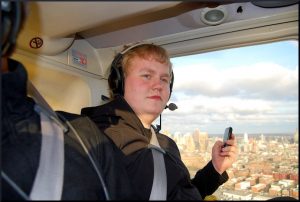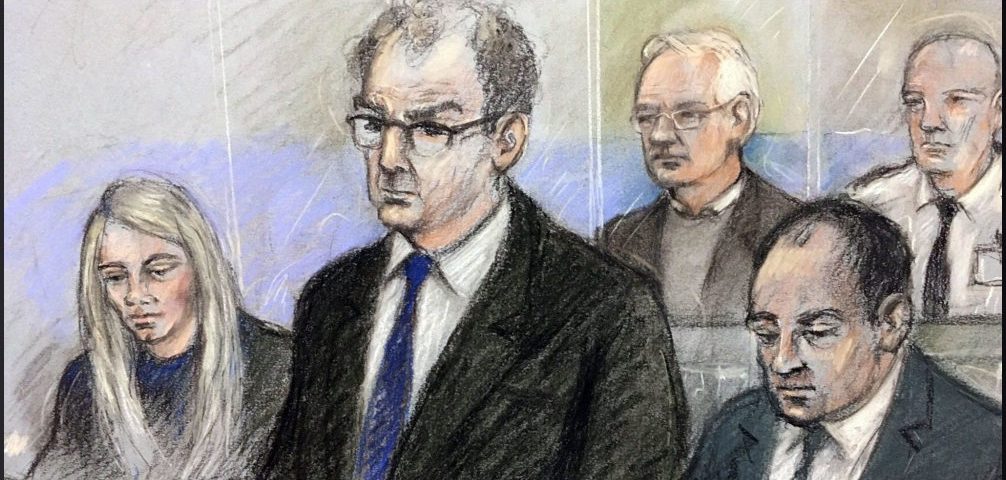by Joe Lauria, published on Consortium News, June 27, 2021
An FBI informant upon whose information the United States based aspects of an indictment against imprisoned WikiLeaks publisher Julian Assange has now admitted that he fabricated the evidence.
Sigudur “Sigi” Ingi Thordarson has told an Icelandic publication in an article that appeared on Saturday that he made up the allegation that Assange asked him to hack a government computer. That testimony played a key part in the indictment against Assange for conspiracy to commit computer intrusion.
Thordarson, 28, is referred to as “Teenager” in the part of the indictment that focuses on events in Iceland, where Assange was working in 2010. The indictment alleges that,
“In early 2010, ASSANGE asked Teenager to commit computer intrusions and steal additional information, including audio recordings of phone conversations between high-ranking officials of the government of NATO Country-I, [Iceland] including members of the Parliament of NATO Country-I.”
Thordarson has now told the publication Stundin that this is a lie. The publication reported:
“In fact, Thordarson now admits to Stundin that Assange never asked him to hack or access phone recordings of MPs. His new claim is that he had in fact received some files from a third party who claimed to have recorded MPs and had offered to share them with Assange without having any idea what they actually contained. He claims he never checked the contents of the files or even if they contained audio recordings as his third party source suggested. He further admits the claim, that Assange had instructed or asked him to access computers in order to find any such recordings, is false.”
This is the end of the case against Julian Assange. https://t.co/bhFCfVBuq0
— Edward Snowden (@Snowden) June 26, 2021
Thordarson’s testimony is contained in a superseding indictment filed by the U.S. Justice Department, which aimed to bolster the conspiracy to commit computer intrusion charge against Assange, carrying a maximum penalty of five years in prison. The indictment also charges Assange under the Espionage Act for unauthorized possession and dissemination of defense information, which could add an additional 170 years in prison.
More ‘Teenager’ Fabrications
The indictment against Assange alleges that “ASSANGE and Teenager failed in their joint attempt to decrypt a file stolen from a NATO Country-1 bank.” Stundin reports:
“Thordarson admits to Stundin that this actually refers to a well publicised event in which an encrypted file was leaked from an Icelandic bank and assumed to contain information about defaulted loans provided by the Icelandic Landsbanki. The bank went under in the fall of 2008, along with almost all other financial institutions in Iceland, and plunged the country into a severe economic crisis. The file was at this time, in summer of 2010, shared by many online who attempted to decrypt it for the public interest purpose of revealing what precipitated the financial crisis. Nothing supports the claim that this file was even ‘stolen’ per se, as it was assumed to have been distributed by whistleblowers from inside the failed bank.”
The indictment alleges that,
“In early 2010; a source provided ASSANGE with credentials to gain unauthorized access into a website that was used by the government of NATO Country-I to track the location of police and first responder vehicles, and agreed that ASSANGE should use those credentials to gain unauthorized access to the website.”
But Thordarson told Stundin
“he had been given this access as a matter of routine due to his work as a first responder while volunteering for a search and rescue team. He also says Assange never asked for any such access.”
Stundin‘s reporting is also based on chat logs between Thordarson and WikiLeaks that Thordarson made available to the publication. The indictment claims that Thordarson acted as a liaison between WikiLeaks and various hacking groups. But Stundin reports:
“The chat logs were gathered by Thordarson himself and give a comprehensive picture of his communications whilst he was volunteering for Wikileaks in 2010 and 11. It entails his talks with WikiLeaks staff as well as unauthorized communications with members of international hacking groups that he got into contact with via his role as a moderator on an open IRC WikiLeaks forum, which is a form of live online chat. There is no indication WikiLeaks staff had any knowledge of Thordarson’s contacts with aforementioned hacking groups, indeed the logs show his clear deception.”
The chat logs show that Thordarson repeatedly asked these groups to carry out hacks. But
“Stundin cannot find any evidence that Thordarson was ever instructed to make those requests by anyone inside WikiLeaks. Thordarson himself is not even claiming that, although he explains this as something Assange was aware of or that he had interpreted it so that this was expected of him. How this supposed non-verbal communication took place he cannot explain.”
It goes on:
“Furthermore, he never explained why WikiLeaks would be interested in attacking any interests in Iceland, especially at such a sensitive time while they were in the midst of publishing a huge trove of US diplomatic cables as part of an international media partnership. Assange is not known to have had any grievances with Icelandic authorities and was in fact working with members of parliament in updating Iceland’s freedom of press laws for the 21st century.”

After WikiLeaks suspected Thordardson of stealing $50,000 in donations, “Teenager” offered his services as an informant to the U.S. embassy in Reykjavik in August 2011. By this time Thordardson was in contact with hacker Hector Xavier Monsegur, known as Sabu, who had been arrested and turned into an FBI asset. Working with the FBI, Sabu arranged a hack of several Icelandic government institutions. Stundin reports:
“Ögmundur Jónasson was minister of interior at time and as such the political head of police and prosecution and says of the US activities: ‘They were trying to use things here [in Iceland] and use people in our country to spin a web, a cobweb that would catch Julian Assange.’”
Shaky Indictment

Given the First Amendment questions being raised about the Espionage Act case against a publisher, Stundin points out that the computer charges against Assange have taken on new significance. In weighing an indictment against Assange in 2010, the Obama administration, in the person of then Vice President Joe Biden, said it sought to prove that Assange did not merely receive stolen defense information but had participated in obtaining it.
“If he conspired to get these classified documents with a member of the U.S. military, that’s fundamentally different than if somebody drops on your lap … to a press person, here is classified material,”
Biden said in December 2010. The Obama administration never indicted Assange.
The central allegation in the Trump administration’s computer intrusion charge is that Assange was a “hacker” and worked with his source, U.S. Army intelligence analyst Chelsea Manning, to crack a password to steal the U.S. government documents.
Thordarson played a key role in supporting the Trump administration case that Assange engaged in hacking when he was interviewed in both Iceland, and then after being flown to Washington in 2019 at U.S. taxpayers’ expense. Stundin also reports that he was given an immunity deal by U.S. authorities.
One year ago WikiLeaks predicted the DOJ would rely on a convicted fraudster, Sigurdur Thordarson, to make up more bogus claims:
June 7 2019 @Wikileaks Press Release ‘DOJ preparing to file additional indictment against #Assange based on testimony by a convicted conman’ pic.twitter.com/9q0aYmCJjM
— WikiLeaks (@wikileaks) June 25, 2020
The DOJ statement at the release of the superseding indictment in June 2020 said:
“The new indictment does not add additional counts to the prior 18-count superseding indictment returned against Assange in May 2019. It does, however, broaden the scope of the conspiracy surrounding alleged computer intrusions with which Assange was previously charged. According to the charging document, Assange and others at WikiLeaks recruited and agreed with hackers to commit computer intrusions to benefit WikiLeaks. …
In addition, the broadened hacking conspiracy continues to allege that Assange conspired with Army Intelligence Analyst Chelsea Manning to crack a password hash to a classified U.S. Department of Defense computer.”
The indictment alleges that Assange was helping Manning sign in as an administrator to a system she had legal access to (as the indictment itself points out), not to access classified information, but instead to download video games, movies and music videos forbidden to U.S. military personnel, Assange’s lawyers argued during the first week of his extradition hearing in February 2020 at Woolwich Crown Court next to Belmarsh Prison in London where Assange is still being held despite his extradition request being rejected based on health grounds. The U.S. has applied for an appeal to the U.K. High Court.
If That Indeed Happened it Was Routine Journalism
In 2010, Robert Parry, the investigative reporter and founder of this website, wrote that the then pending plans of the Obama administration to indict Assange “for conspiring with Army Pvt. Bradley Manning to obtain U.S. secrets, strikes at the heart of investigative journalism on national security scandals.”

Parry wrote:
“That’s because the process for reporters obtaining classified information about crimes of state most often involves a journalist persuading some government official to break the law either by turning over classified documents or at least by talking about the secret information. There is almost always some level of ‘conspiracy’ between reporter and source.” [Emphasis added.]
Parry thus admitted to encouraging his sources to turn over classified information even if it meant committing the lesser crime of leaking government secrets if it could help prevent a larger crime from being committed. In this way Assange encouraged Manning to turn over material such as the “Collateral Murder” video in the hope that it could end the illegal war in Iraq.
“In most cases, I played some role – either large or small – in locating the classified information or convincing some government official to divulge some secrets. More often than not, I was the instigator of these ‘conspiracies,’”
Parry wrote. He added:
“Whether cajoling a nervous government official to expose a secret or exploiting some unauthorized access to classified material – is part of what an investigative journalist does in covering national security abuses. The traditional rule of thumb has been that it’s the government’s job to hide the secrets and a reporter’s job to uncover them.”
The indictment itself against Assange makes plain that he was merely trying to protect the identity of his source. It says: “Such a measure would have made it more difficult for investigators to identify Manning as the source of unauthorized disclosures of classified information.”
Dismantling the persecution of #Assange:
2019: UK torture & arbitrariness exposed
2019: Swedish rape allegations collapse
2020: Embassy surveillance exposed
2021: US prisons declared inhumane
2021: US hacking allegations collapse
Time to end this travesty!https://t.co/1uzdtPhd1u— Nils Melzer (@NilsMelzer) June 26, 2021
Not ‘Technically Possible’
The charge of conspiracy to commit computer was further undermined during the resumption of Assange’s extradition hearing in September by the testimony of computer expert Patrick Ellis. He said on the witness stand that it wasn’t technically possible for Manning to crack the password and that even if it had been it wouldn’t have helped Manning access the files.
“Manning already had legitimate access to all of the databases from which she downloaded data,” Ellis said in written submissions to the court. “Logging into another user account would not have provided her with more access than she already possessed.”
He added:
“She already had authorization [to access the datasets]. It is unclear to me that any anonymity would be gained by cracking the password to gain access to the ftp user account. Even if Manning was in fact logged into the ftp user account rather than her own normal account, this would have no effect on tracking. Merely logging into a different local user account on the computer (such as ftp user) would not anonymize Manning at all because the IP address of the computer would remain the same regardless of what user account is in use.”
Eller testified that it wasn’t technically possible for Manning to do what the government alleged because Microsoft issued a patch in December 1999 to protect against an attack by strongly encrypting the password. The indictment admits that the attempt by Manning to sign in under an administrative password failed.
Who Was ‘Nathaniel Frank?’
The entire government case on the conspiracy to commit computer intrusion charged is based on an assumption that Manning was speaking with Assange in a Jabar chat when they discussed the password matter in March 2010. The chat log, obtained by the U.S. government, shows Manning chatting with someone named “Nathaniel Frank.” It has not been proven in court that Frank was Assange.
WikiLeaks has called Thordarson, “a diagnosed sociopath, a convicted conman, and sex criminal” who had impersonated Assange to embezzle money from WikiLeaks. Thordarson was convicted in 2014 of the theft while he was an FBI informant.
WikiLeaks has not alleged that Frank was Thordarson, who was not yet working with the FBI in 2010. But it was at the time of the Jabar chat that he began volunteering with WikiLeaks. The indictment against Assange says:
“In early 2010, around the same time that ASSANGE was working with Manning to obtain classified information, ASSANGE met a 17-year old in NATO Country-I (‘Teenager’).”
The ‘Star Witness’ of the new superseding indictment is a diagnosed sociopath/ convicted conman/ child abuser/ FBI informant who was found guilty in Iceland of impersonating #Assange https://t.co/Gd249hthhj
— WikiLeaks (@wikileaks) June 25, 2020
*Featured Image: Above photo: Julian Assange (back) listened in the dock as James Lewis (front, centre) opened the hearing with the US position. ~Popular Resistance
Joe Lauria is editor-in-chief of Consortium News and a former correspondent for The Wall Street Journal, Boston Globe, Sunday Times of London and numerous other newspapers. He began his professional career as a stringer for The New York Times. He can be reached at joelauria@consortiumnews.com and followed on Twitter @unjoe .
